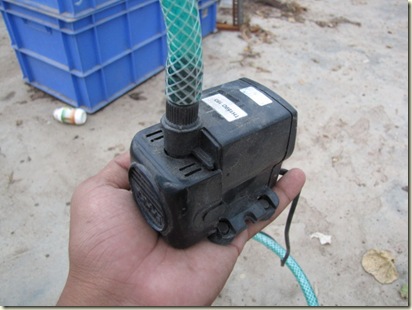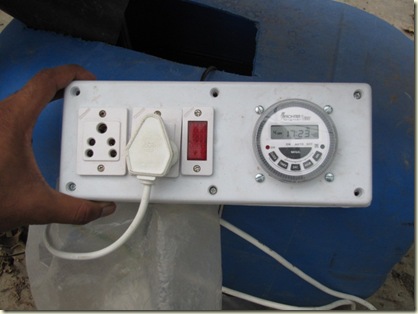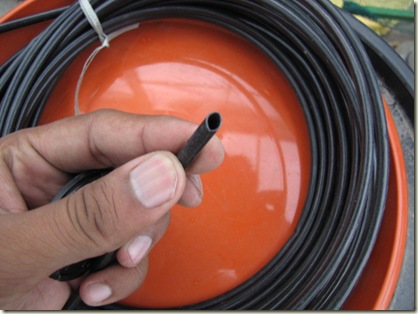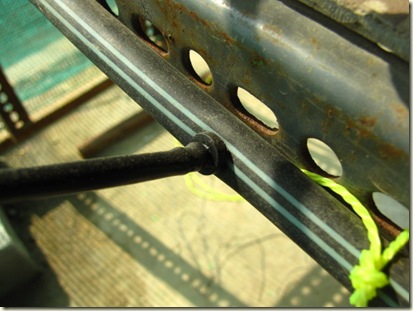I have been
giving the following article—an overview of our approach to flock
management—as the handout for my poultry seminars for several years.
I am now
writing a replacement which will address the same issues, but will
emphasize five areas: Pasturing the flock (using electronet fencing),
“putting the flock to work” in various homestead endeavors, deep litter
for best management of manure in the poultry house, using natural
mothers for incubating and brooding new stock, and feeding issues. I
will eventually post the new version on the site. ~February 2007
Getting Started
Chickens are
the easiest of all livestock to raise. Their needs for feed and shelter
are easily met. The eggs and meat you can get from a home flock will be
superior to anything you can buy. And a flock of chickens is an endless
source of fascination for the whole family. Give them a try!
Choosing a Breed
If your main
interest in chickens is egg production, you might choose one of the
Mediterranean class breeds - Leghorns, Golden or Silver Campines,
Buttercups, Hamburgs, Blue Andalusians, Minorcas, etc. These breeds tend
to be somewhat smaller and lighter in weight, as they put more of their
resources into egg production rather than larger frames and greater
muscle mass. They usually lay white eggs. Some of these breeds can a bit
high-strung.
Meat breeds are
typified by the Cornish Cross, a very fast-growing hybrid with a broad,
plump breast, easy to dress out. These birds can be ready for slaughter
at seven or eight weeks. (If slaughtered at 12-14 weeks they produce
excellent roasters.) Because they grow so fast, they are not as vigorous
or resilient as others, and easily expire from episodes of sudden
stress. [Some breeders in the "pastured poultry" movement are trying to
breed new broiler crosses especially for production on pasture that are
considerably more robust than the Cornish Cross. Typically, such birds
require a little longer grow-out than the Cornish; but exhibit better
vigor, none of the leg and heart problems of the Cornish, yet dress out
with the sort of plump, broad breast the market has come to expect.]
Many people
prefer a compromise between the meat and the egg "specialists": The
dual-purpose breeds, which lay well (usually brown shelled eggs) and
grow fast enough to serve well as table fowl (though they are not as
broad breasted as the meat-production hybrids). Birds of this type are
ready for slaughter at about 12 or 13 weeks of age. They are usually
more gentle and easy-going than the Mediterranean group. Among these
breeds are New Hampshire and Rhode Island Reds, Barred Rocks, Buff
Orpingtons, Brahmas, Cochins, Wyandottes, and Ameraucanas (which lay
pastel-tinted eggs).
Usually the
discussion of breed choice ends here. However, I urge you to consider
also the historic breeds, such as the five-toed Dorkings, which
originated in Rome before the time of Julius Caesar. While not as
productive as modern breeds, the historic breeds have other virtues to
recommend them. For example, Old English Games may not be ready for
slaughter until five months old and may lay only 200 eggs a year - but
they can virtually feed themselves if given enough space to forage; the
hens are devoted and fiercely protective mothers; and their meat was
once the standard against which all other table fowl were judged.
Sources for Stock
Just-hatched
chicks can be sent through the mail. Many people turn first to one of
the mega-hatcheries such as Murray McMurray. They feature large
selections and illustrated catalogs. My own preference is to seek out
smaller, family owned regional hatcheries, which I have found may
provide more personalized service and superior stock.
You can get
both chicks and started stock from the local farmers co-op, though the
choice of breeds is very limited. You can also connect with local
enthusiasts who have stock to sell through classified ads or a
publication such as the Valley Trader.
Finally, of
course, you can breed your own. This may not be a realistic option if
you're just starting out. But at some time in the future, you may find
that it is quite a thrill to "hatch your own." You might try your luck
with an artificial incubator. Or, if you're lucky enough to have a
broody hen, you can just "let mama do it."
Brooding
If you start
with day-old stock, you will have to be a surrogate mama to your baby
chicks. Set up an enclosed brooder which is free from drafts and
protected from rodents, cats, etc.; and which contains an absorbent
litter such as wood shavings and a source of heat such as a 250-watt
lamp or two. The waterer should be designed so that the chicks cannot
wade into it and get wet. Temperature should be maintained so that the
chicks are neither huddling under the heat source, nor huddling in a
corner as far as possible from the heat. If they are scooting around the
brooder like a bunch of little water bugs, all is well. Frequent
monitoring of the brooder is the key to success.
Of course, if
you have a mother hen who is raising your new chicks, you don't have to
worry about any of this. When it comes to raising baby chickens, a
mother hen is a lot smarter than you.
Housing
Housing for
chickens can be extremely simple. If you already have an existing shed
or outbuilding, it can probably be modified to serve quite nicely. The
fundamental requirements are that the birds be protected from the wind
or heavy drafts; and that they be completely dry. Chickens have a strong
instinct to roost; so will be more content if furnished with some
structure on which to roost.
It is important
not to overcrowd your birds. Allow a minimum of three square feet per
bird, up to an ideal five square feet or more. Of course, if the flock
has constant access to the outside, they will do fine with less space in
their "sleeping quarters" inside.
If you plan to
build a new structure in which to house your birds, I strongly recommend
that you keep an earth floor in the building, and cover it with a thick
layer of high-carbon litter such as oak leaves, wood shavings, etc. (I
do not think straw is a good litter material over earth floor, as it can
support the growth of molds which can be a respiratory problem for the
birds.) The constant scratching of the chickens incorporates the
droppings into the litter, preventing the typical "caking" of manure
which results in foul odors, flies, and possible buildup of pathogens.
The constant mixing of the manure with the high-carbon litter results in
a decomposition process similar to that in a compost pile. The billions
of microorganisms driving this decomposition actually produce Vitamins K
and B12, various natural antibiotics, and other immune-enhancing
substances which the chickens ingest while scratching for and eating
tiny critters in the litter. A study in the Ohio state university system
in the 1920's demonstrated that chickens could obtain 100% of their
protein from a mature 12-inch litter. You can periodically (say once a
year) remove the litter and use it as compost without further
processing.
If you have to
use an existing building with a wood floor, that's okay. Here, too, you
should lay down a thick layer of dry, high-carbon litter. (In this case,
where the litter remains dry, a straw litter is okay.) Your poultry
house will be far more pleasant for you and more healthful for the
chickens. When you remove a mix of litter and manure from a structure
with a wooden floor, you should compost it before adding it to the
garden.
Whenever you
notice a strong odor of ammonia, especially upon opening the poultry
house in the morning, it is time either to clean out the litter, or add
another layer of high-carbon material.
Joel Salatin
has observed that, if allowed five square feet per bird, the chickens
will continually turn in all manure laid down. At four square feet,
there will be some "capping" of manure (accumulation of an impervious
layer the birds cannot incorporate), especially under the roosts. At
three square feet, there can be capping over all or most of the litter.
If you find that the manure is building up in this way, simply use a
spading fork to turn over the capped areas in clumps. The chickens will
then be able to break up the clumps and work them into the litter.
Whatever
shelter you give your birds should protect them from wind and sharp
drafts; but at the same time should allow for adequate ventilation. I
installed solid outer doors and inner frame doors with wire mesh. This
configuration allows me to open up the house completely to air flow,
while still keeping the birds confined and protected when desired. Also,
the birds are able to sun themselves in the direct sunlight coming
through the mesh doors and windows at various times during the day.
Please note
that, if their shelter is tight and dry, chickens are very cold hardy.
It is not necessary to provide artificial heat; and it could be
detrimental to do so. [Occasionally single-comb cocks will get some
frostbite on combs or wattles. If this becomes a serious problem, you
could keep breeds with rose or pea combs instead.]
You will of
course design your housing with predator protection (especially at
night) in mind. But don't anticipate threats like dogs, raccoons, and
foxes only - a least weasel can get through any opening large enough for
a rat! (I once lost 19 young chickens to a least weasel!) And speaking
of rats: Remember that they can be a serious threat to chicks. Half-inch
hardware cloth is a great thing!
Feeding
Commercial
poultry feed contains products from rendering plants, reprocessed
deep-frying oil, feather meal, and other low quality ingredients which
can be quite stale by the time it is fed. For these reasons I prefer to
grind my own feed every few days, using certified organic ingredients I
buy from Countryside Natural Products near Staunton. Making your own
feed may not be a realistic option for you. Countryside also offers
premixed versions of the feeds I make, in 50-lb. bags. Fortunately, they
are now delivering once a month into the Northern Virginia area. Call
them at 888-699-7088 for more information about products and deliveries,
or visit Countryside Natural Products.
However, if
local commercial feed is the only realistic alternative for you, by all
means use it. If your birds have access to pasture, your eggs and
dressed poultry will still be superior to any you can buy. If you do use
commercial feeds, keep a couple of precautions in mind. Chickens are
appropriately fed different mixes at different stages of growth, varying
especially with regard to proportions of protein and of minerals,
particularly calcium. It is important to feed your birds appropriate to
their stage of growth. However, you should strictly avoid feeding chicks
a chick formula containing antibiotics. Feeding such medications as a
steady part of the diet is completely unnecessary in a small batch of
chicks not stressed by crowding such as yours; and excessive use of
antibiotics in our food supply has serious long-term implications for
both animal and human health. If you cannot get an antibiotic-free
starter mix (such as Countryside's), I suggest starting your chicks on
the next stage formula ("grower mix" or "pullet developer") instead,
perhaps supplementing with a little fish meal to boost the protein.
When using
commercial feeds, you can also add a little kelp (dried seaweed) meal,
an excellent natural all-round mineral supplement.
Whatever you
feed, always make sure your birds have daily access to some green
forage. When they are confined to the winter housing, you can dig
dandelion and yellow dock up by the roots and throw them to the flock -
the tops stay green much longer than other forage plants, and they are
very palatable and highly nutritious to poultry. If you have a
greenhouse, set aside a little space for greens (assorted grains,
mustards, kale, rape, and other cold-hardy greens are good candidates)
for the birds. Or sprout some of those same seeds and expose them to
sunlight long enough for them to green up, then toss them to the flock.
Remember, you don't need to feed a lot of green forage - even small
amounts are highly beneficial.
You should also
feed the flock grit (small bits of stone and gravel, which they need
for grinding their feed in the gizzard) and, in the case of layers,
crushed oyster shell as a calcium supplement. These amendments are not
so important for birds on pasture, since they are able to pick up what
they need on their own. I usually offer them anyway, since it is easy to
do so and they are cheap; but they should always be provided
(free-choice) to birds confined to the winter housing. Grit and shell
are available at any farm co-op or feed supply.
Watering
Chickens must
have fresh water available at all times. Waterers come in a number of
designs. Choose a type which minimizes the surface area exposed, so the
water will remain as clean and litter-free as possible. Placing it above
floor level on a stand will also help minimize contamination with
litter. Guard against wet spots under or around the waterer. (Pathogens
are more likely to grow in wet than in dry litter.) If wet spots do
develop, use a spading fork to scatter the wet material so it can dry as
the chickens work it into the rest of the litter.
I recommend
some form of automated watering, which saves a significant amount of
time and effort even in a small flock. There are various designs of
vacuum-flow and float-activated waterers. The most sanitary of all
watering systems is the nipple waterer.
Of course,
watering becomes a greater challenge during freezing winter weather. If
electricity is available in the poultry house, there are various heating
devices that can be used. Carrying the waterer into the basement at
night is also an option.
Eggs
 Be
sure to provide sufficient nest boxes (maybe one for each seven to nine
hens or so) positioned above floor level; keep them lined with plenty
of clean straw; and collect eggs frequently. All these measures help
keep the eggs clean and unbroken, and reduce the likelihood of egg
eating, a bad habit which - once established - is difficult to break.
Be
sure to provide sufficient nest boxes (maybe one for each seven to nine
hens or so) positioned above floor level; keep them lined with plenty
of clean straw; and collect eggs frequently. All these measures help
keep the eggs clean and unbroken, and reduce the likelihood of egg
eating, a bad habit which - once established - is difficult to break.
I prefer not to
wash eggs if they come perfectly clean from the nest. (They actually
keep better if not washed.) If they have even the slightest trace of
litter or - yes, occasionally - poop, I wash them with a half and half
solution of water and vinegar, which dissolves the smear and has a
sanitizing effect.
Fresh eggs do
not need to be refrigerated if eaten within a few days. Just set them
out of direct sunlight where it is not too warm. (Remember, in nature
the mother bird doesn't refrigerate her eggs. They remain perfectly
viable for up to two weeks as she day by day assembles her clutch before
starting incubation.)
©Unless
otherwise noted, all material on this site, both text and photos, is
copyright by Harvey and Ellen Ussery, 2005 to the present. Individuals
may copy and circulate it freely under the following conditions: This
site www.TheModernHomestead.US must be attributed as the source; any
material copied must include this copyright notice; and no charge may be
made if you pass copies on to others, other than the actual costs of
copying, if any. No material on this site may be published in any print
or electronic media, whether or not for profit, without written
permission of Harvey or Ellen Ussery.
DISCLAIMER:
Information offered on this website is based on decades of research and
practical experience. However, we are not trained professionals in any
health, environmental, or other field. We therefore do not offer the
contents of this website as advice or recommendation for any specific
practice; nor will we be responsible for the consequences of the
application of any information or ideas presented on this site. ~Harvey
and Ellen Ussery
 This
plant usually grows slowly inside a house–purchase a large, more mature
one if possible. If a young one is your only option, you can still use
it for first aid treatments but know it will take a few years to get
large.
This
plant usually grows slowly inside a house–purchase a large, more mature
one if possible. If a young one is your only option, you can still use
it for first aid treatments but know it will take a few years to get
large.
 This
plant usually grows slowly inside a house–purchase a large, more mature
one if possible. If a young one is your only option, you can still use
it for first aid treatments but know it will take a few years to get
large.
This
plant usually grows slowly inside a house–purchase a large, more mature
one if possible. If a young one is your only option, you can still use
it for first aid treatments but know it will take a few years to get
large.












































